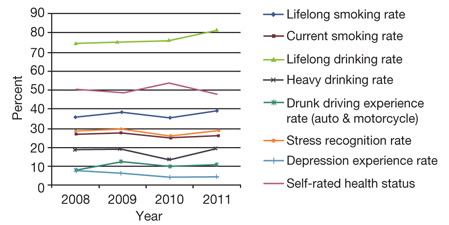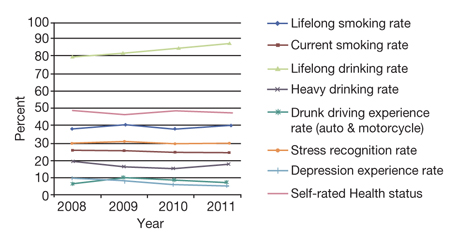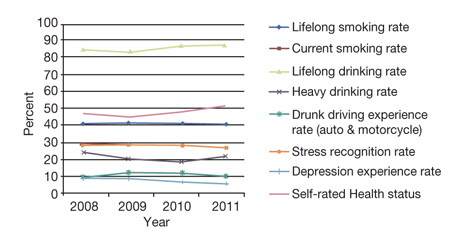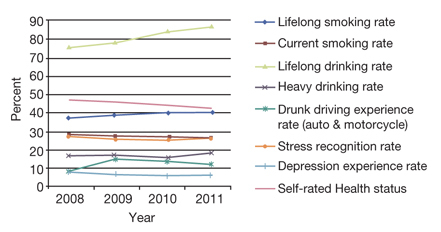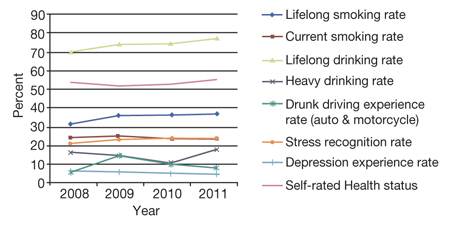J Korean Med Assoc.
2012 May;55(5):491-498. 10.5124/jkma.2012.55.5.491.
Relationship between policy dispute on Sejong City planning and local residents' health status
- Affiliations
-
- 1Department of Preventive Medicine, Soonchunhyang University College of Medicine, Cheonan, Korea. parky@sch.ac.kr
- KMID: 2064806
- DOI: http://doi.org/10.5124/jkma.2012.55.5.491
Abstract
- Recently, Sejong City had been in the center of a policy dispute about city planning in Korea. Although Sejong City was chosen to be a new Multifunctional Administrative City in 2006, politicians continued to challenge the decision at the city level from 2009 upto 2010.This study aims to investigate what influences, such as the policy dispute, impacted the health behaviors and the mental health of local people. We used the survey data from the Community Health Survey in 2008, 2009, 2010, and 2011 and compared the results through logistic regression analysis and direct standardization. Data were gathered from residents in Chungcheongnam-do, the province where Sejong City is located. Data from residents of four other provinces were used as a control: Gangwon-do, Gyeongsangbuk-do, Jeonlanam-do, and Gyeonggi-do. We found a significant increase in smoking and drinking rates in the residents of Chungcheongnam-do, which are indicators of health behaviors, in the year of 2009 when the Sejong City dispute erupted. It appears that controversial changes in government policy could have negative influences on local people. Therefore, we need proper measures to prevent them.
Keyword
MeSH Terms
Figure
Reference
-
1. Acheson D. Great Britain, Her Majesty's Stationery Office. Independent inquiry into inequalities in health. 1998. London: Stationery Office.2. Ansari Z, Carson NJ, Ackland MJ, Vaughan L, Serraglio A. A public health model of the social determinants of health. Soz Praventivmed. 2003. 48:242–251.
Article3. Park DB. A participatory research on the residents' communicative action for the environmental movements as a community development project in a Korean village. J Korean Reg Dev Assoc. 1999. 7–27.4. Kahng TG. The impact of the developments and dwellers on the beach and sanddune characteristics in the Chungcheong-Namdo province. J Environ Impact Assess. 2003. 12:291–302.5. Korea Centers for Disease Control and Prevention. Community health survey 2008. 2009. Cheongwon: Korea Centers for Disease Control and Prevention.6. Lee SH. The social cultural effects of 'traditional culture policies' on 'Jeonju Hanok Village' and its residents. J Reg Stud. 2011. 19:109–135.7. Hwang YY, Chu MS. Depression according to health perception and health practice among the aged in an area. J Korean Acad Community Health Nurs. 2007. 18:583–592.8. Brennan PL, Schutte KK, Moos RH. Reciprocal relations between stressors and drinking behavior: a three-wave panel study of late middle-aged and older women and men. Addiction. 1999. 94:737–749.
Article
- Full Text Links
- Actions
-
Cited
- CITED
-
- Close
- Share
- Similar articles
-
- A Review on The Process of Comprehensive Health Planning
- Necessity of Analyzing the Korea Community Health Survey Using 7 Local Government Types
- Issues, improvements and policy directions in residency program in Korea
- Epidemiological Investigation for Outbreak of Clostridium perfringens Enteritis among Students at a College in 2018
- Factors Influencing Suicidal Ideation According to the Deprivation Indices of Different Regions in Korea

